Alfa Romeo 4C 2015 Owner handbook (in English)
Manufacturer: ALFA ROMEO, Model Year: 2015, Model line: 4C, Model: Alfa Romeo 4C 2015Pages: 199, PDF Size: 7.67 MB
Page 61 of 199
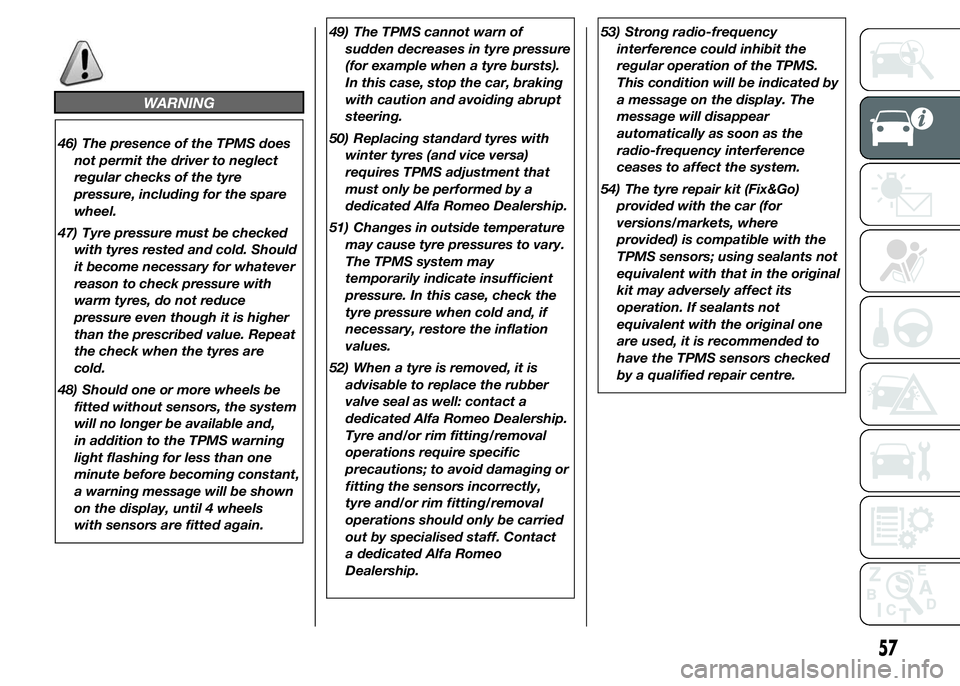
WARNING
46) The presence of the TPMS does
not permit the driver to neglect
regular checks of the tyre
pressure, including for the spare
wheel.
47) Tyre pressure must be checked
with tyres rested and cold. Should
it become necessary for whatever
reason to check pressure with
warm tyres, do not reduce
pressure even though it is higher
than the prescribed value. Repeat
the check when the tyres are
cold.
48) Should one or more wheels be
fitted without sensors, the system
will no longer be available and,
in addition to the TPMS warning
light flashing for less than one
minute before becoming constant,
a warning message will be shown
on the display, until 4 wheels
with sensors are fitted again.49) The TPMS cannot warn of
sudden decreases in tyre pressure
(for example when a tyre bursts).
In this case, stop the car, braking
with caution and avoiding abrupt
steering.
50) Replacing standard tyres with
winter tyres (and vice versa)
requires TPMS adjustment that
must only be performed by a
dedicated Alfa Romeo Dealership.
51) Changes in outside temperature
may cause tyre pressures to vary.
The TPMS system may
temporarily indicate insufficient
pressure. In this case, check the
tyre pressure when cold and, if
necessary, restore the inflation
values.
52) When a tyre is removed, it is
advisable to replace the rubber
valve seal as well: contact a
dedicated Alfa Romeo Dealership.
Tyre and/or rim fitting/removal
operations require specific
precautions; to avoid damaging or
fitting the sensors incorrectly,
tyre and/or rim fitting/removal
operations should only be carried
out by specialised staff. Contact
a dedicated Alfa Romeo
Dealership.53) Strong radio-frequency
interference could inhibit the
regular operation of the TPMS.
This condition will be indicated by
a message on the display. The
message will disappear
automatically as soon as the
radio-frequency interference
ceases to affect the system.
54) The tyre repair kit (Fix&Go)
provided with the car (for
versions/markets, where
provided) is compatible with the
TPMS sensors; using sealants not
equivalent with that in the original
kit may adversely affect its
operation. If sealants not
equivalent with the original one
are used, it is recommended to
have the TPMS sensors checked
by a qualified repair centre.
57
Page 62 of 199

REFUELLING THE
CAR
IN BRIEF
The car features the "Fast Fuel"
system, which prevents refuelling
with incorrect fuels (e.g. diesel for a
petrol engine).
Stop the engine before refuelling.
Only refuel with unleaded petrol with
octane rating (RON) not less than
95, in compliance with the European
specification EN228. In particular,
the 4C’s engine has been designed
to comply with all emission limits
while simultaneously guaranteeing
minimal consumption and maximum
performance, using premium-quality
unleaded petrol with octane rating
(RON) of 98 or higher.
In order to prevent damage to the
catalytic converter never introduce
even the smallest amount of leaded
petrol, even in the event of an
emergency.
IMPORTANT An inefficient catalytic
converter leads to harmful exhaust
emissions, thus contributing to air
pollution.IMPORTANT Never introduce leaded
petrol to the tank, even in small
amounts in an emergency, as this
would damage the catalytic converter
beyond repair.
FILLING THE TANK
To ensure that you fill the tank
completely, top up twice after the first
click of the fuel supply gun. Avoid
further top-ups, which could cause
faults in the fuel supply system.
REFUELLING
PROCEDURE
The car features a "Fast Fuel" device,
integrated with the opening for the fuel
tank: it opens and recloses
automatically when the fuel supply gun
is inserted/removed.
The "Fast Fuel" device is provided with
an inhibitor which prevents refuelling
with incorrect fuel.
The refuelling procedure described
below is illustrated on the label fig. 56
located inside the fuel flap. The label
also indicates the fuel type (UNLEADED
FUEL=petrol).Procedure
❒open flap A fig. 57, pulling it
outwards;
❒introduce the dispenser in the filler
and refuel;
❒after refuelling, before removing the
dispenser, wait for at least 10
seconds in order for the fuel to flow
inside the tank;
❒then remove the dispenser from the
filler and close flap A.
Flap A fig. 57 is provided with a dust
cover gaiter B which prevents deposits
of impurities and dust at the end of
the filler when the flap is closed.
55) 56) 57)
56A0L0045
58
GETTING TO KNOW YOUR CAR
Page 63 of 199
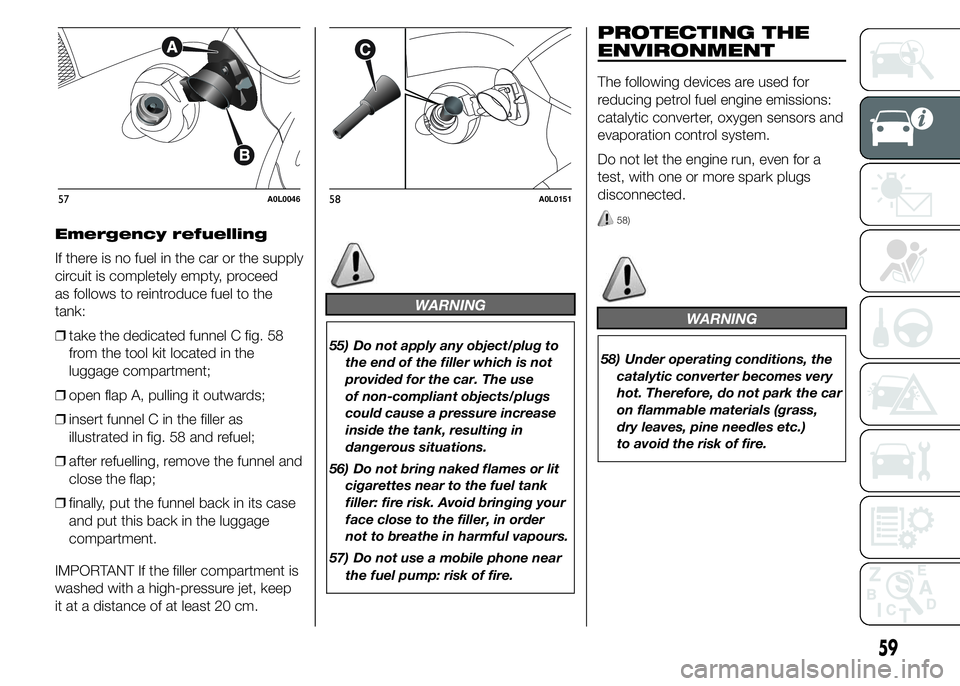
Emergency refuelling
If there is no fuel in the car or the supply
circuit is completely empty, proceed
as follows to reintroduce fuel to the
tank:
❒take the dedicated funnel C fig. 58
from the tool kit located in the
luggage compartment;
❒open flap A, pulling it outwards;
❒insert funnel C in the filler as
illustrated in fig. 58 and refuel;
❒after refuelling, remove the funnel and
close the flap;
❒finally, put the funnel back in its case
and put this back in the luggage
compartment.
IMPORTANT If the filler compartment is
washed with a high-pressure jet, keep
it at a distance of at least 20 cm.
WARNING
55) Do not apply any object/plug to
the end of the filler which is not
provided for the car. The use
of non-compliant objects/plugs
could cause a pressure increase
inside the tank, resulting in
dangerous situations.
56) Do not bring naked flames or lit
cigarettes near to the fuel tank
filler: fire risk. Avoid bringing your
face close to the filler, in order
not to breathe in harmful vapours.
57) Do not use a mobile phone near
the fuel pump: risk of fire.
PROTECTING THE
ENVIRONMENT
The following devices are used for
reducing petrol fuel engine emissions:
catalytic converter, oxygen sensors and
evaporation control system.
Do not let the engine run, even for a
test, with one or more spark plugs
disconnected.
58)
WARNING
58) Under operating conditions, the
catalytic converter becomes very
hot. Therefore, do not park the car
on flammable materials (grass,
dry leaves, pine needles etc.)
to avoid the risk of fire.
57A0L004658A0L0151
59
Page 64 of 199

60
This page is intentionally left blank
Page 65 of 199
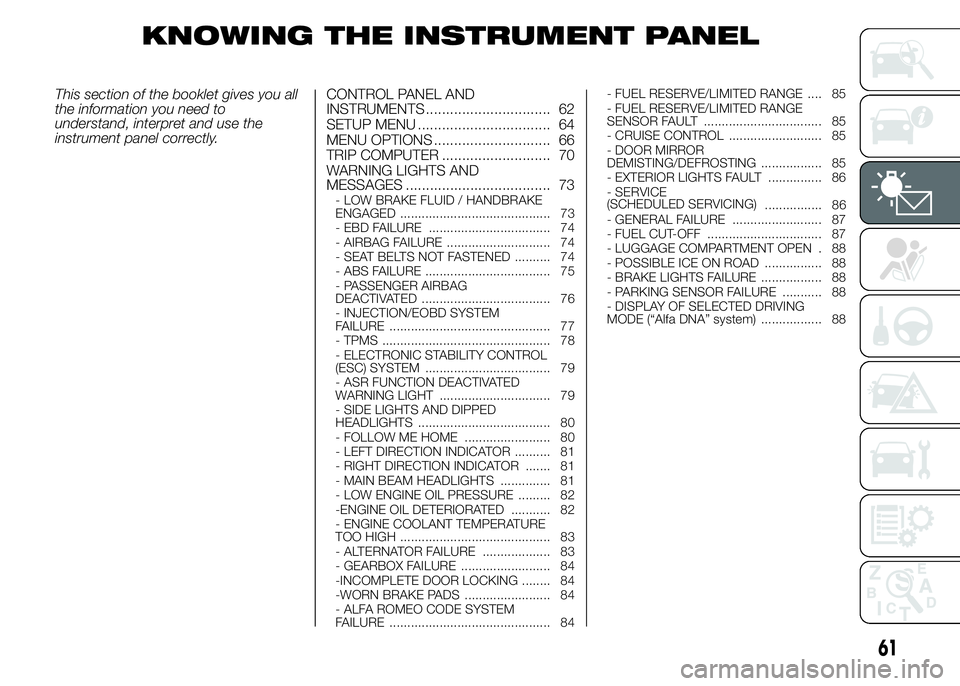
KNOWING THE INSTRUMENT PANEL
This section of the booklet gives you all
the information you need to
understand, interpret and use the
instrument panel correctly.CONTROL PANEL AND
INSTRUMENTS ............................... 62
SETUP MENU ................................. 64
MENU OPTIONS ............................. 66
TRIP COMPUTER ........................... 70
WARNING LIGHTS AND
MESSAGES .................................... 73
- LOW BRAKE FLUID / HANDBRAKE
ENGAGED .......................................... 73
- EBD FAILURE .................................. 74
- AIRBAG FAILURE ............................. 74
- SEAT BELTS NOT FASTENED .......... 74
- ABS FAILURE ................................... 75
- PASSENGER AIRBAG
DEACTIVATED .................................... 76
- INJECTION/EOBD SYSTEM
FAILURE ............................................. 77
- TPMS ............................................... 78
- ELECTRONIC STABILITY CONTROL
(ESC) SYSTEM ................................... 79
- ASR FUNCTION DEACTIVATED
WARNING LIGHT ............................... 79
- SIDE LIGHTS AND DIPPED
HEADLIGHTS ..................................... 80
- FOLLOW ME HOME ........................ 80
- LEFT DIRECTION INDICATOR .......... 81
- RIGHT DIRECTION INDICATOR ....... 81
- MAIN BEAM HEADLIGHTS .............. 81
- LOW ENGINE OIL PRESSURE ......... 82
-ENGINE OIL DETERIORATED ........... 82
- ENGINE COOLANT TEMPERATURE
TOO HIGH .......................................... 83
- ALTERNATOR FAILURE ................... 83
- GEARBOX FAILURE ......................... 84
-INCOMPLETE DOOR LOCKING ........ 84
-WORN BRAKE PADS ........................ 84
- ALFA ROMEO CODE SYSTEM
FAILURE ............................................. 84- FUEL RESERVE/LIMITED RANGE .... 85
- FUEL RESERVE/LIMITED RANGE
SENSOR FAULT ................................. 85
- CRUISE CONTROL .......................... 85
- DOOR MIRROR
DEMISTING/DEFROSTING ................. 85
- EXTERIOR LIGHTS FAULT ............... 86
- SERVICE
................ 86
- GENERAL FAILURE ......................... 87
- FUEL CUT-OFF ................................ 87
- LUGGAGE COMPARTMENT OPEN . 88
- POSSIBLE ICE ON ROAD ................ 88
- BRAKE LIGHTS FAILURE ................. 88
- PARKING SENSOR FAILURE ........... 88
- DISPLAY OF SELECTED DRIVING
MODE (“Alfa DNA” system) ................. 88
61
(SCHEDULED SERVICING)
Page 66 of 199

CONTROL PANEL AND INSTRUMENTS.
Display with metric units
A. Engine coolant temperature indicator – B. Time – C. Rev counter – D. Mode/gear engaged indicator – E. Gear change suggestion (Gear Shift
Indicator) – F. Outside temperature – G. Fuel level gauge (the triangle on the right side of thesymbol indicates the side of the car with the fuel
filler) – H. Area dedicated to the display of the digital warning light related to the displayed message – I. Trip milometer – J. Speedometer (Speed
indicator) – K. "Alfa DNA" system driving mode – L. Messages or information on display – M. Milometer
59A0L0118
62
KNOWING THE INSTRUMENT PANEL
Page 67 of 199

Display with imperial units
A. Engine coolant temperature indicator – B. Time – C. Rev counter – D. Mode/gear engaged indicator – E. Gear change suggestion (Gear Shift
Indicator) – F. Outside temperature – G. Fuel level gauge (the triangle on the right side of thesymbol indicates the side of the car with the fuel
filler) – H. Area dedicated to the display of the digital warning light related to the displayed message – I. Trip milometer – J. Speedometer (Speed
indicator) – K. "Alfa DNA" system driving mode – L. Messages or information on display – M. Milometer
60A0L0129
63
Page 68 of 199
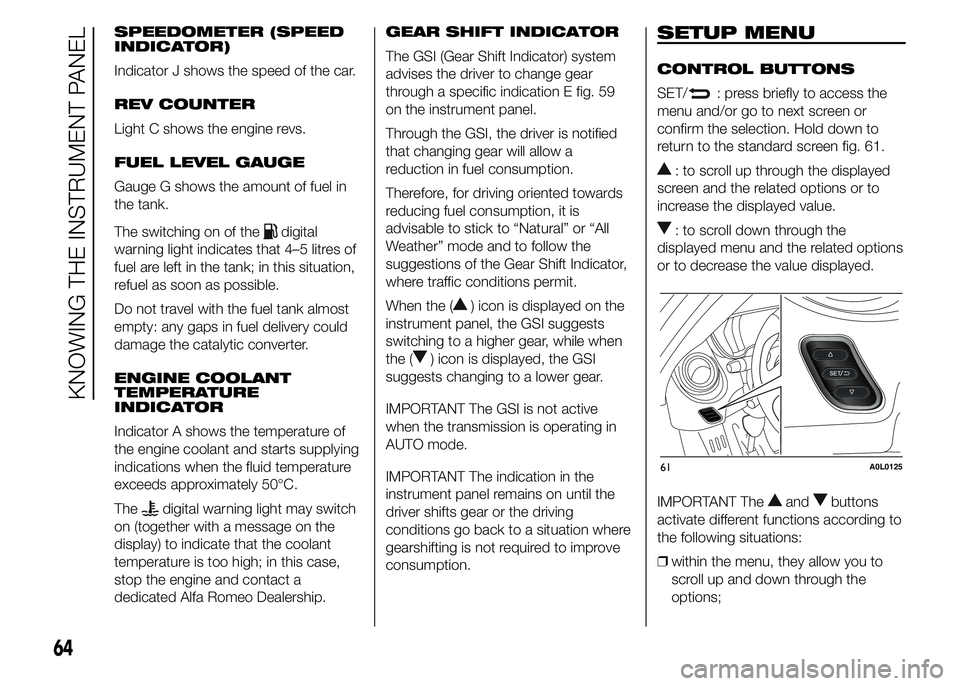
SPEEDOMETER (SPEED
INDICATOR)
Indicator J shows the speed of the car.
REV COUNTER
Light C shows the engine revs.
FUEL LEVEL GAUGE
Gauge G shows the amount of fuel in
the tank.
The switching on of the
digital
warning light indicates that 4–5 litres of
fuel are left in the tank; in this situation,
refuel as soon as possible.
Do not travel with the fuel tank almost
empty: any gaps in fuel delivery could
damage the catalytic converter.
ENGINE COOLANT
TEMPERATURE
INDICATOR
Indicator A shows the temperature of
the engine coolant and starts supplying
indications when the fluid temperature
exceeds approximately 50°C.
The
digital warning light may switch
on (together with a message on the
display) to indicate that the coolant
temperature is too high; in this case,
stop the engine and contact a
dedicated Alfa Romeo Dealership.GEAR SHIFT INDICATOR
The GSI (Gear Shift Indicator) system
advises the driver to change gear
through a specific indication E fig. 59
on the instrument panel.
Through the GSI, the driver is notified
that changing gear will allow a
reduction in fuel consumption.
Therefore, for driving oriented towards
reducing fuel consumption, it is
advisable to stick to “Natural” or “All
Weather” mode and to follow the
suggestions of the Gear Shift Indicator,
where traffic conditions permit.
When the (
) icon is displayed on the
instrument panel, the GSI suggests
switching to a higher gear, while when
the (
) icon is displayed, the GSI
suggests changing to a lower gear.
IMPORTANT The GSI is not active
when the transmission is operating in
AUTO mode.
IMPORTANT The indication in the
instrument panel remains on until the
driver shifts gear or the driving
conditions go back to a situation where
gearshifting is not required to improve
consumption.
SETUP MENU
CONTROL BUTTONS
SET/
: press briefly to access the
menu and/or go to next screen or
confirm the selection. Hold down to
return to the standard screen fig. 61.
: to scroll up through the displayed
screen and the related options or to
increase the displayed value.
: to scroll down through the
displayed menu and the related options
or to decrease the value displayed.
IMPORTANT The
andbuttons
activate different functions according to
the following situations:
❒within the menu, they allow you to
scroll up and down through the
options;
61A0L0125
64
KNOWING THE INSTRUMENT PANEL
Page 69 of 199
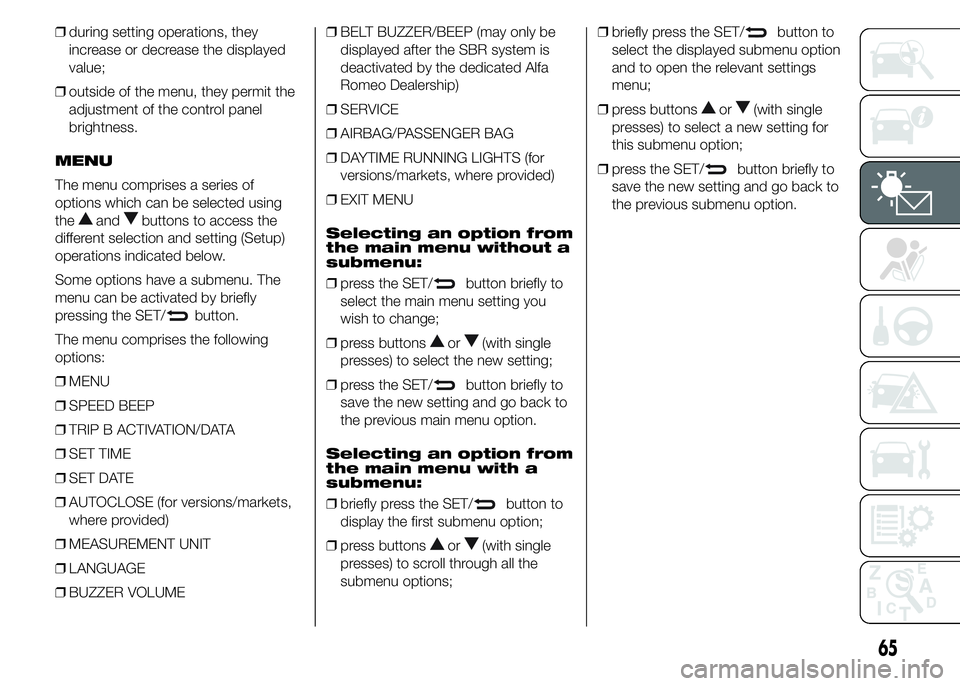
❒during setting operations, they
increase or decrease the displayed
value;
❒outside of the menu, they permit the
adjustment of the control panel
brightness.
MENU
The menu comprises a series of
options which can be selected using
the
andbuttons to access the
different selection and setting (Setup)
operations indicated below.
Some options have a submenu. The
menu can be activated by briefly
pressing the SET/
button.
The menu comprises the following
options:
❒MENU
❒SPEED BEEP
❒TRIP B ACTIVATION/DATA
❒SET TIME
❒SET DATE
❒AUTOCLOSE (for versions/markets,
where provided)
❒MEASUREMENT UNIT
❒LANGUAGE
❒BUZZER VOLUME❒BELT BUZZER/BEEP (may only be
displayed after the SBR system is
deactivated by the dedicated Alfa
Romeo Dealership)
❒SERVICE
❒AIRBAG/PASSENGER BAG
❒DAYTIME RUNNING LIGHTS (for
versions/markets, where provided)
❒EXIT MENU
Selecting an option from
the main menu without a
submenu:
❒press the SET/
button briefly to
select the main menu setting you
wish to change;
❒press buttons
or(with single
presses) to select the new setting;
❒press the SET/
button briefly to
save the new setting and go back to
the previous main menu option.
Selecting an option from
the main menu with a
submenu:
❒briefly press the SET/
button to
display the first submenu option;
❒press buttons
or(with single
presses) to scroll through all the
submenu options;❒briefly press the SET/
button to
select the displayed submenu option
and to open the relevant settings
menu;
❒press buttons
or(with single
presses) to select a new setting for
this submenu option;
❒press the SET/
button briefly to
save the new setting and go back to
the previous submenu option.
65
Page 70 of 199
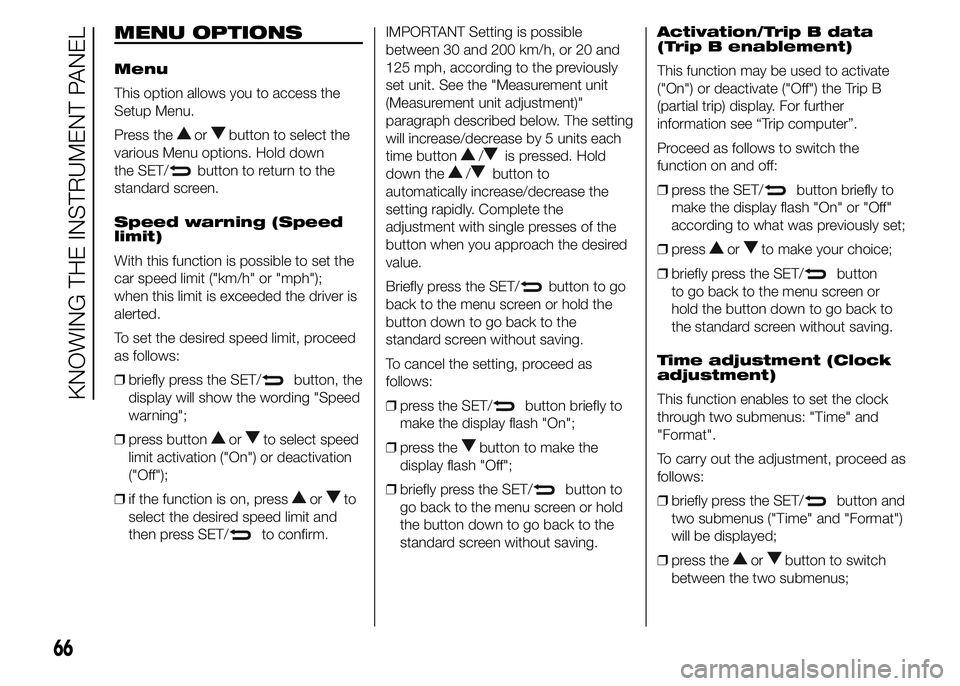
MENU OPTIONS
Menu
This option allows you to access the
Setup Menu.
Press the
orbutton to select the
various Menu options. Hold down
the SET/
button to return to the
standard screen.
Speed warning (Speed
limit)
With this function is possible to set the
car speed limit ("km/h" or "mph");
when this limit is exceeded the driver is
alerted.
To set the desired speed limit, proceed
as follows:
❒briefly press the SET/
button, the
display will show the wording "Speed
warning";
❒press button
orto select speed
limit activation ("On") or deactivation
("Off");
❒if the function is on, press
orto
select the desired speed limit and
then press SET/
to confirm.IMPORTANT Setting is possible
between 30 and 200 km/h, or 20 and
125 mph, according to the previously
set unit. See the "Measurement unit
(Measurement unit adjustment)"
paragraph described below. The setting
will increase/decrease by 5 units each
time button
/is pressed. Hold
down the
/button to
automatically increase/decrease the
setting rapidly. Complete the
adjustment with single presses of the
button when you approach the desired
value.
Briefly press the SET/
button to go
back to the menu screen or hold the
button down to go back to the
standard screen without saving.
To cancel the setting, proceed as
follows:
❒press the SET/
button briefly to
make the display flash "On";
❒press the
button to make the
display flash "Off";
❒briefly press the SET/
button to
go back to the menu screen or hold
the button down to go back to the
standard screen without saving.Activation/Trip B data
(Trip B enablement)
This function may be used to activate
("On") or deactivate ("Off") the Trip B
(partial trip) display. For further
information see “Trip computer”.
Proceed as follows to switch the
function on and off:
❒press the SET/
button briefly to
make the display flash "On" or "Off"
according to what was previously set;
❒press
orto make your choice;
❒briefly press the SET/
button
to go back to the menu screen or
hold the button down to go back to
the standard screen without saving.
Time adjustment (Clock
adjustment)
This function enables to set the clock
through two submenus: "Time" and
"Format".
To carry out the adjustment, proceed as
follows:
❒briefly press the SET/
button and
two submenus ("Time" and "Format")
will be displayed;
❒press the
orbutton to switch
between the two submenus;
66
KNOWING THE INSTRUMENT PANEL